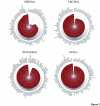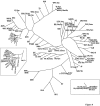A set of highly informative rat simple sequence length polymorphism (SSLP) markers and genetically defined rat strains
- PMID: 16584579
- PMCID: PMC1475628
- DOI: 10.1186/1471-2156-7-19
A set of highly informative rat simple sequence length polymorphism (SSLP) markers and genetically defined rat strains
Abstract
Background: The National Bio Resource Project for the Rat in Japan (NBRP-Rat) is focusing on collecting, preserving and distributing various rat strains, including spontaneous mutant, transgenic, congenic, and recombinant inbred (RI) strains. To evaluate their value as models of human diseases, we are characterizing them using 109 phenotypic parameters, such as clinical measurements, internal anatomy, metabolic parameters, and behavioral tests, as part of the Rat Phenome Project. Here, we report on a set of 357 simple sequence length polymorphism (SSLP) markers and 122 rat strains, which were genotyped by the marker set.
Results: The SSLP markers were selected according to their distribution patterns throughout the whole rat genome with an average spacing of 7.59 Mb. The average number of informative markers between all possible pairs of strains was 259 (72.5% of 357 markers), showing their high degree of polymorphism. From the genetic profile of these rat inbred strains, we constructed a rat family tree to clarify their genetic background.
Conclusion: These highly informative SSLP markers as well as genetically and phenotypically defined rat strains are useful for designing experiments for quantitative trait loci (QTL) analysis and to choose strategies for developing new genetic resources. The data and resources are freely available at the NBRP-Rat web site 1.
Figures




Similar articles
-
Genetic and phenotypic characterization of a Japanese wild-derived DOB/Oda rat strain.Mamm Genome. 2013 Aug;24(7-8):303-8. doi: 10.1007/s00335-013-9465-z. Epub 2013 Jul 30. Mamm Genome. 2013. PMID: 23896813
-
Evaluation of LEXF/FXLE rat recombinant inbred strains for genetic dissection of complex traits.Physiol Genomics. 2008 Feb 19;32(3):335-42. doi: 10.1152/physiolgenomics.00158.2007. Epub 2007 Nov 27. Physiol Genomics. 2008. PMID: 18042833
-
The development of a highly informative mouse Simple Sequence Length Polymorphism (SSLP) marker set and construction of a mouse family tree using parsimony analysis.Genome Res. 2003 Mar;13(3):485-91. doi: 10.1101/gr.717903. Genome Res. 2003. PMID: 12618379 Free PMC article.
-
National BioResource Project-Rat and related activities.Exp Anim. 2009 Jul;58(4):333-41. doi: 10.1538/expanim.58.333. Exp Anim. 2009. PMID: 19654430 Review.
-
Role of rat strain in the differential sensitivity to pharmaceutical agents and naturally occurring substances.J Toxicol Environ Health. 1996 Jan;47(1):1-30. doi: 10.1080/009841096161960-2840. J Toxicol Environ Health. 1996. PMID: 8568909 Review.
Cited by
-
Genetic quality assurance and genetic monitoring of laboratory mice and rats: FELASA Working Group Report.Lab Anim. 2020 Apr;54(2):135-148. doi: 10.1177/0023677219867719. Epub 2019 Aug 20. Lab Anim. 2020. PMID: 31431136 Free PMC article.
-
A revamped rat reference genome improves the discovery of genetic diversity in laboratory rats.bioRxiv [Preprint]. 2023 Sep 28:2023.04.13.536694. doi: 10.1101/2023.04.13.536694. bioRxiv. 2023. Update in: Cell Genom. 2024 Apr 10;4(4):100527. doi: 10.1016/j.xgen.2024.100527. PMID: 37214860 Free PMC article. Updated. Preprint.
-
Identification of the genetic background of laboratory rats through amplicon-based next-generation sequencing for single-nucleotide polymorphism genotyping.BMC Genom Data. 2024 Oct 3;25(1):84. doi: 10.1186/s12863-024-01267-1. BMC Genom Data. 2024. PMID: 39363223 Free PMC article.
-
Genes unlinked to the leptin receptor influence urinary albumin excretion in obese Zucker rats.Physiol Genomics. 2010 May;41(3):297-305. doi: 10.1152/physiolgenomics.90367.2008. Epub 2010 Feb 16. Physiol Genomics. 2010. PMID: 20159938 Free PMC article.
-
Genetic and phenotypic characterization of a Japanese wild-derived DOB/Oda rat strain.Mamm Genome. 2013 Aug;24(7-8):303-8. doi: 10.1007/s00335-013-9465-z. Epub 2013 Jul 30. Mamm Genome. 2013. PMID: 23896813
References
-
- National Bio Resource Project for the Rat in Japan http://www.anim.med.kyoto-u.ac.jp/NBR
-
- Kwitek AE, Gullings-Handley J, Yu J, Carlos DC, Orlebeke K, Nie J, Eckert J, Lemke A, Andrae JW, Bromberg S, et al. High-density rat radiation hybrid maps containing over 24,000 SSLPs, genes, and ESTs provide a direct link to the rat genome sequence. Genome Res. 2004;14:750–757. doi: 10.1101/gr.1968704. - DOI - PMC - PubMed
Publication types
MeSH terms
Substances
LinkOut - more resources
Full Text Sources
Research Materials
Miscellaneous

